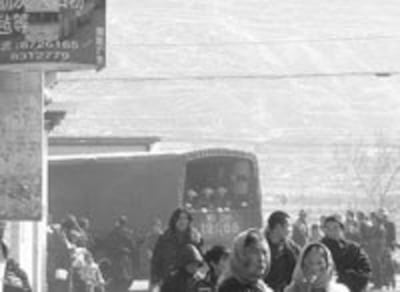KATHMANDU—Sources in the Amdo region of eastern Tibet report a major clash between Chinese authorities and hundreds of Tibetans gathered for an annual prayer festival, with scores of monks detained.

Chinese authorities in Rebkong [in Chinese, Tongren] county, Malho prefecture, in China's remote northwestern Qinghai province, ordered the prayer festival stopped and sent in three truckloads of armed police after a clash erupted on Feb. 21, the sources said.
“They used tear gas, and most of the 200 Tibetans who were detained were monks from the area,” one source told RFA’s Tibetan service.
“Many of the monks who were detained were participating in a masked dance performance, so they couldn’t perform the dance, which is a major event in the Monlam festival,” which was to conclude Feb. 22, the source said.
The local government has organized a fireworks event for the Monlam festival in recent years, and this year’s event drew thousands of spectators. Up to 200 armed and unarmed police were sent into the crowd, possibly to prevent anti-Chinese protests, the sources said.
Other protests erupt
When police tried to question one man, other Tibetans gathered around him, and a group of Tibetans outside a restaurant began shouting slogans and attacking police with sticks and stones, witnesses said.
Under the pressure of a massive Tibetan demonstration, the local government had to release all those who were arrested on the first day of protest. Many of them were severely beaten and tortured.
Other protests erupted around the same time, and the crowds damaged seven Chinese government vehicles, they said. Authorities sent in more police, and around 200 people—mostly monks—were detained. Most have since been released, they said.
“During the clash and protests, many Tibetans raised slogans for the independence of Tibet and prayed for the Long Life of His Holiness the Dalai Lama. So the Tibetan demonstrations went on until about 10 p.m.,” one source said.
“When police detained some monks and took them away, [the people] protested more intensely. Under the pressure of a massive Tibetan demonstration, the local government had to release all those who were arrested on the first day of protest. Many of them were severely beaten and tortured. Two of them who were really serious were taken away to Xining for treatment,” the source said.
Official announcement
“Such torture further enraged Tibetan demonstrators, and they refused to stop. Finally the head lama of Rebkong Monastery intervened, and only then the demonstration came to an end. So at the end even the traditional mask dance was also performed.”
Rebkong police declined to comment when reached by telephone. But the local government posted a statement in the town saying: “Local Tibetans gathered for the Monlam festival protested when police interrogated a Tibetan. Those Tibetan youths who were involved in the protests were interrogated and those who were slightly injured were handed over to their parents for advice and guidance. So the county is peaceful as before.”
The incident follows months of escalating tensions in traditionally Tibetan areas of what is now western China, with Chinese authorities taking a tougher line against what they regard as ethnic “splittism,” or resistance to Chinese rule in the region.
The exiled Tibetan leader, the Dalai Lama, has lived in northern India since 1959 after a failed uprising against Chinese rule. Revered as a god-king by his own people, the Dalai Lama is persona non grata among Chinese authorities—who have ruled him out entirely of Tibet's future.
Center of 2006 fur fracas
Rebkong county was the center of campaign, led by the Dalai Lama, two years ago to discourage Tibetans from wearing fur. The Dalai Lama urged Tibetans to stop wearing traditional furs and protect andangered animals.
Residents began burning tiger, leopard, and sea otter skins publicly against the wishes of Chinese authorities, who responded by ordering Tibetan broadcasts to wear furs on the air.
In recent years, China has stepped up propaganda aimed at Qinghai’s Tibetans, launching a new channel broadcasting 17.5 hours of programs daily in the Amdo dialect, including news broadcasts, dubbed movies, and dramas. Amdo speakers can be found in Qinghai, Gansu, and Sichuan provinces.
Original reporting by RFA's Amdo Tibetan service and by Dolkar for RFA's Uke Tibetan service. Edited and translated by Karma Dorjee. Tibetan service director: Jigme Ngapo. Written and produced in English by Sarah Jackson-Han.
